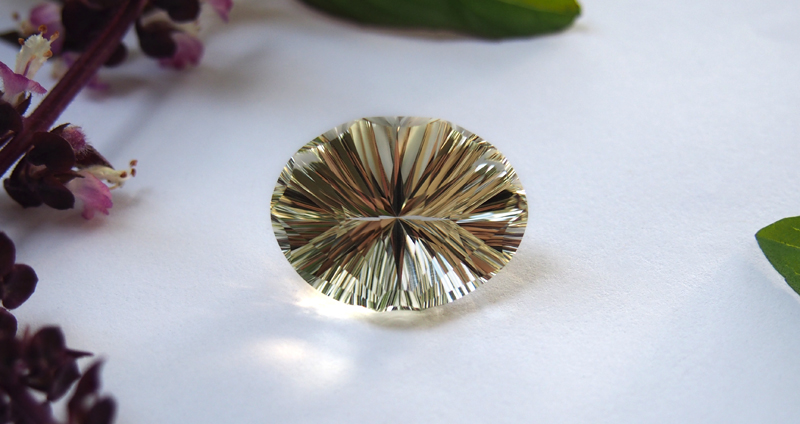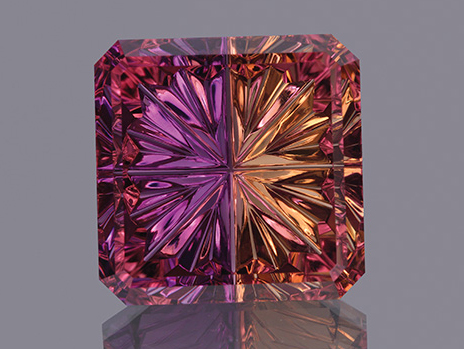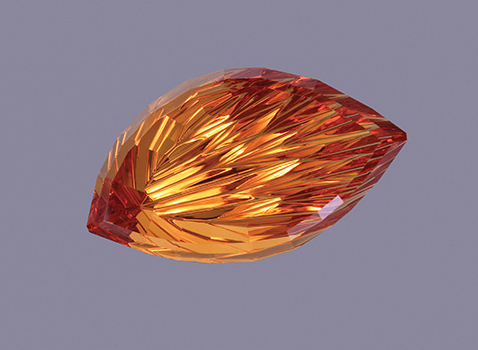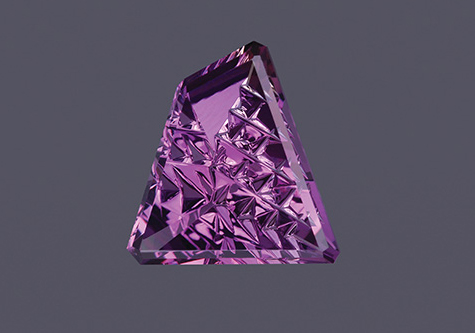Cutting differently: Inside the whimsical world of fantasy gems
September 28, 2022
By Lauriane Lognay

A 31.36-carat fantasy cut sunrise quartz.
Photo by Gabrielle Belanger-Girard, Rippana Inc.
"The role of a traditional gem cutter is no walk in the park. Whether faceting, cabochon, or carving, it is vital to arm oneself with patience, discipline, and, of course, a pair of practiced eyes to see a gemstone’s full potential. Beyond this, these professionals must be armed with the proper tools. Faceting and/or cabochon machines, countless flat laps, bands with different grits, various diamond powders, index gears, snake oil, water, aluminum oxide, and much more are needed to achieve perfection.
What is cutting, though? Simply put, this refers to the action of taking a gem and grinding it down using different grits and powders to achieve symmetrical or fantasy facets on its surface. It is a mechanical action, guided by the steady hands of a lapidary artist. A bit of a labour of love, many careful actions and hours of work are required to shape a crystal from its rough and create a gem. Each piece is carefully analyzed and cut to meet point with the help of a diagram and, again, a pair of practiced eyes.
When discussing cutting, I always say, “Never cut with a troubled mind; the stone will feel it.” Indeed, if you dive in while sleep deprived or with problems swirling through your head, more often than not, the result will mirror your mind. Nothing will go your way.
Cutting is a nuanced art form, yes, but also a difficult trade to learn. Knowledge is often passed down from master to apprentice, or absorbed via countless hours practicing, studying, and learning through trial and error. Lapidary schools are rare if they exist at all. In North America, those who pursue the field do so because of passion and a love for the trade.
Each gemstone is cut using different methods and grits—each and every one of them is also polished in a different way. To further complicate matters, individual lapidary artists perform different steps and polishes for various types of gemstones. Combinations are limitless.
Dreaming in fantasy

44.37-carat Bolivian ametrine ‘Starbrite’ gem by John Dyer & Co.
Photo by Ozzie Campos/courtesy John Dyer & Co.
When it comes to gemstone cuts, most are familiar with the classics—round brilliant, emerald, oval, princess, and so on—but what of fantasy cuts?
Gems, typically, can be considered alongside levels of difficulty in a video game: in easy mode, you buy pre-cut gems; in medium mode, you cut gems yourself; and, finally, in hard mode, you cut them while incorporating your own signature style and artistic flair. This idea can be taken a step further with the creation of unique jewellery and bespoke pieces.
Fantasy cutting requires not only lapidary and faceting skills, but also a dedicated desire on the part of the cutter to develop their own style—sometimes jewellery professionals even have to build their own tools to create their trademark of fantasy cutting. (You need a specifically shaped diamond burr to make an indent into your stone? Pack your diamond paste and toolmaking skills and invent your tool!)
With this, a cutter can achieve anything: grooves, concave faceting, curved shapes, and so on. There are countless possibilities and combinations, from carving, faceting, and carving, to cabochon and faceting mix, to freeform cutting, concave facets, half-rough/half-cut. Each style can be further refined and adapted to suit its very own gemstone owner. Fantasy cutting can also create optical illusions or realistic looking sculptures. It can dive into fantastical or abstract art.
Each style is meant to bring to life the potentially award-winning stone a cutter hopes to create. Lapidaries work with specific characteristics of the gem, creating a design accounting for its hardness, refracting light, reflection of light from within, orientation needed to get the right colour, and so forth.
Each cut gemstone is like a painting: unique and brilliant in its own right. As a gem professional and admirer, I could easily write for hours about different shapes, the varying types of grooves and polishes, and the vast artists who work to tirelessly in the world of cutting. For the purposes of this column, however, I would like to dig a little deeper and dissect something many jewellery retailers might not often see: the steps taken when cutting a fantasy gem. When we consider the journey of a gemstone from its rough, to the gem dealer, to the lapidary artist, to the setter, and, finally, to the showcase, we begin to have an increased understanding of this somewhat outlandish art.
Step by step
The step-by-step journey of creating a fantasy-cut tourmaline. Drawing by Lauriane Lognay
(photo not copyable, use link to view)
Whether cutting a fantasy gem or something more traditional, the steps are, generally, as follows:
* A rough gem is acquired—for this example, let’s say pink tourmaline.
* Develop a design specifically for the gemstone’s refractive index (in the case of tourmaline, this is 1.62 to 1.64). This means there are certain angles to respect with the facets to make the particular gem’s colour stand out:
* If the angle is too low, this will create a window inside the stone (i.e. the light will not reflect and, instead, go right through the stone)
* If the angle is too high, it will cause a dead zone with no light (i.e. the light will get stuck inside the stone with no good reflective surface)
* Decide where to cut the grooves, lines, and fantasy shapes into the stone. Be careful to avoid fissures and unwanted inclusions—the design will have to consider all zones inside the rough that cannot be used.
* Determine if the stone should be cut lengthwise or widthwise. Tourmaline poses an added challenge in this regard, as the rough grows lengthwise (i.e. an elongated crystal with a triangular cross section). If it is not cut in this direction, more than 60 per cent of the rough will be lost—however, often the best colour is found widthwise. So, the choice is often between a better colour saturation (i.e. dark pink) or a bigger stone for a better wield (i.e. pale pink—the less desirable colour).
* Pre-shape the rough, cutting out the parts that can’t or won’t be used and making the stone into a rough shape of the design imagined. This process often reveals hidden inclusions and dangers inside the rough. If this occurs, revisit the original design to see if it should be altered to suit the rough’s new shape. Typical wield is between 30 to 60 per cent loss of material inside a stone.
This is where fantasy cuts offer a bit of an advantage, as this style allows for a more flexible result (depending on the shape desired and whether some surface inclusions can be cut out using carving techniques, grooves, and a bit of luck).
* Using the tools you have crafted to achieve your signature gemstone curves and shapes, cut into the stone. You now have to invent these same tools again with different grits until the polishing stage (meaning, around three to four times the same tool with grits like 200-600-1200-3000, and so forth until the final polish).
Bespoke pieces
For designers, maintaining a close relationship with a local cutter is, in my opinion, a necessity—particularly when working with fantasy gems. In addition to repairs and polishes, these professionals are able to craft masterpiece gemstones that can be incorporated into unique and high-end jewellery to dazzle in your showcase. These artists can create one-of-a-kind collections, as well as interesting gemstones to be used in more traditional settings and solitaire rings. In short, they create style!
Keeping pace with the growing consumer demand for unique, show-stopping jewellery, the world of fantasy cuts has picked up steam in recent years, with the work of many talented artists gaining global traction. John Dyer, Michael Peuster, Victor Tuzlukov, and Dalan Hargrave are among the many world-renowned designers to find a following.
Are you ready to enter the fantasy world? ... "


https://www.jewellerybusiness.com/featu ... tasy-gems/